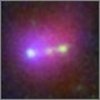Astronomy & Cosmology -
Galaxies
Lyman Alpha Blobs (LABs)
Lyman-alpha Blobs are huge clouds of gas; sort of proto-galaxies yet to start star production. Astronomers believe that they are powered by immense central black holes. As matter spirals into the black hole, it gets heated, and begins to glow at a variety of frequencies up to X-rays. This energy does not come from within the black hole, which is not possible, but from the area outside of the event horizon as inflowing material forms an accretion disk around the black hole. It is the black hole itself that stops the "blobs" from starting to collapse and form stars. The radiation essentially stops the gravitational collapse that would occur. Eventually, the black hole "eats up" all the nearby available matter and stops radiating, so that the normal process of star and galaxy formation begins. Thus, the LAB is probably the early stage of galaxy formation.
The image on the right shows one of the largest blobs observed, and is is several hundred thousand light-years across. It is a composite image, and I have included the key in the enlarged image. We are seeing it when the Universe was only about 2 billion years old; that is, as it was nearly 12 billion years ago. The light we are seeing was emitted when the "blob" was about 11.5 billion light years away. Whatever it has become is much further away "now" due to the expansion of the Universe.
Himiko is a newly discovered cloud that predates similar Lyman-alpha blobs. To date, it is the most massive object ever discovered in the early universe. It is so distant from Earth that we see it when the Universe was only about 800 million years old. It is said to hold more than 10 times as much mass as the next largest object found in the early universe, or roughly the equivalent mass of 40 billion suns. At 55,000 light years across, it spans about half the diameter of our Milky Way Galaxy. Some LABs, located when the Universe was only about two billion years old, are more than 400,000 light years across. One group of LABs, found in 2000, extends over a distance of approximately 200 million light years.
Here is a short video about Lyman Alpha Blobs.
The image on the right shows one of the largest blobs observed, and is is several hundred thousand light-years across. It is a composite image, and I have included the key in the enlarged image. We are seeing it when the Universe was only about 2 billion years old; that is, as it was nearly 12 billion years ago. The light we are seeing was emitted when the "blob" was about 11.5 billion light years away. Whatever it has become is much further away "now" due to the expansion of the Universe.
Himiko is a newly discovered cloud that predates similar Lyman-alpha blobs. To date, it is the most massive object ever discovered in the early universe. It is so distant from Earth that we see it when the Universe was only about 800 million years old. It is said to hold more than 10 times as much mass as the next largest object found in the early universe, or roughly the equivalent mass of 40 billion suns. At 55,000 light years across, it spans about half the diameter of our Milky Way Galaxy. Some LABs, located when the Universe was only about two billion years old, are more than 400,000 light years across. One group of LABs, found in 2000, extends over a distance of approximately 200 million light years.
Here is a short video about Lyman Alpha Blobs.
A picture of a LAB
NASA/ESA, CXC,
JPL-Caltech, STScI, NAOJ, Geach et al.
JPL-Caltech, STScI, NAOJ, Geach et al.
Himiko
NGC2244



